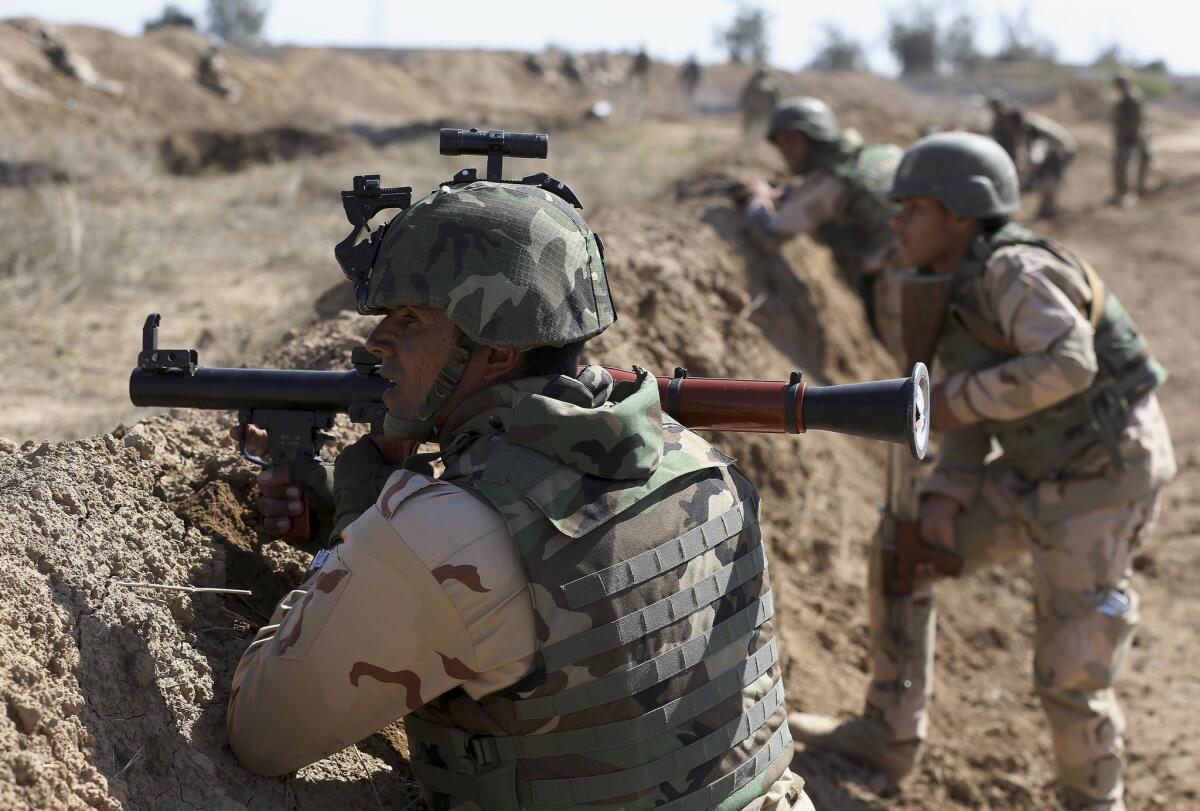Editorial: Signs of mission creep are multiplying in the fight against ISIS in Iraq

Iraqi security forces participate in a drill as U.S. forces train them in Taji, north of Baghdad, Iraq, in 2015.
- Share via
Almost five years ago, President Obama delivered a speech in which he acknowledged — and claimed credit for — the fact that the last U.S. combat troops would soon be leaving Iraq. “The tide of war is receding,” Obama said on Oct. 21, 2011.
What Obama didn’t anticipate was that Islamic State, an offshoot of Al Qaeda in Iraq, would seize large amounts of territory in Iraq and Syria, inspiring and orchestrating terrorist attacks in the West. So in 2014 Obama promised to “degrade and ultimately destroy” Islamic State, but without getting “dragged into another ground war in Iraq.”
There are now about 4,000 U.S. troops in Iraq, officially in a training and advisory role but increasingly in harm’s way.
So far, the president has abided by that pledge. Yet signs of mission creep in Iraq are multiplying. There are now about 4,000 U.S. troops in Iraq, officially in a training and advisory role but increasingly in harm’s way. After a Navy SEAL was killed coming to the rescue of Kurdish and Christian fighters near Mosul, Defense Secretary Ashton Carter said: “It is a combat death, of course.”
More such casualties are possible as U.S. forces assist in the counteroffensive designed to expel Islamic State from territory it occupies, a campaign that has achieved some success but faces significant challenges. Even if the casualty count remains small, the history of U.S. military involvement in the Middle East — and elsewhere, notably Vietnam — will inspire concern that the U.S. is on a slippery slope to just the sort of large-scale commitment Obama has forsworn.
One way to counter such concerns — and constrain Obama and his successor — is for Congress to approve an Authorization for Use of Military Force against Islamic State. Strangely, the administration is conducting its campaign against that group under resolutions passed during the George W. Bush administration that provided authorization both for retaliation against Al Qaeda after the Sept. 11 attacks and for the 2003 invasion of Iraq.
Obama has proposed a three-year AUMF that supposedly would rule out a repeat of the Iraq and Afghanistan wars, but its wording could justify lengthy and large-scale deployments so long as they were described as temporary and defensive. Congress needs to adopt more restrictive language.
Even if Congress imposes limits on U.S. involvement, the depressing prospect for the foreseeable future is that the U.S. — ideally with more support from its regional allies — will be engaged in a significant and at times dangerous struggle with Islamic State and similar groups, with no guarantee of achieving all of its objectives. For example, even if Islamic State were defeated in Iraq and Syria, political instability in both countries and elsewhere could give rise to similar insurgencies. As even the intervention-averse Obama has realized, it is impossible to extricate the U.S. entirely from a conflict that’s metastasizing in many locations.
The tide of war has receded, but not as far as he or we thought in 2011.
Follow the Opinion section on Twitter @latimesopinion and Facebook
More to Read
A cure for the common opinion
Get thought-provoking perspectives with our weekly newsletter.
You may occasionally receive promotional content from the Los Angeles Times.









